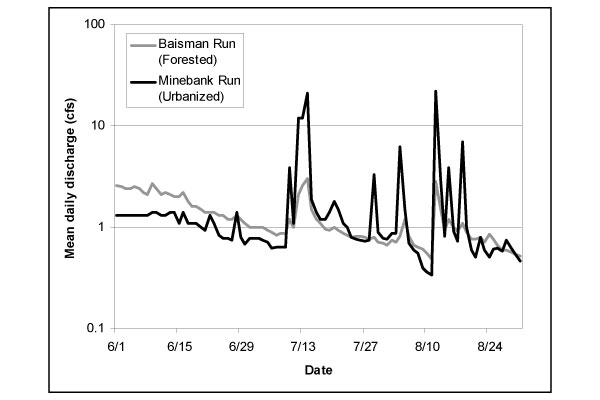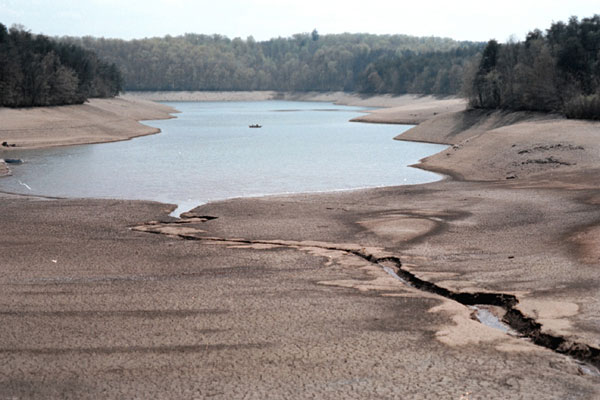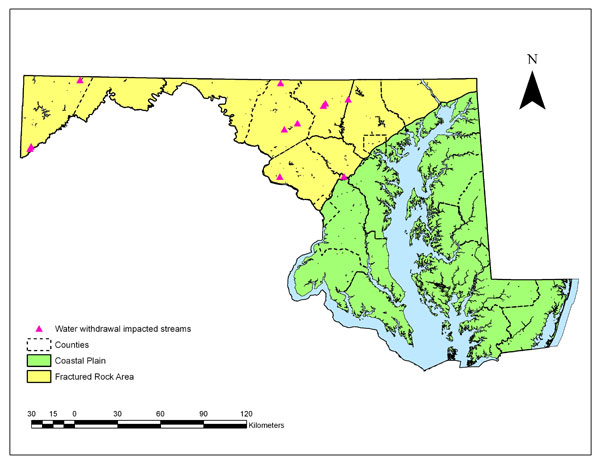Environmental Flows

Note: Click any image to enlarge
Stream flow helps shape many of the physical and biological characteristics seen in aquatic ecosystems. Aquatic organisms, like fish, crayfish, aquatic insects, and freshwater mussels, have adapted to a range and variability of flow over time that can be characterized as the natural flow regime. Alteration of natural flow regimes, from direct and indirect actions, has been pervasive for over a century and has generally resulted in the degradation of many streams. For example, dams alter the quantity, timing, and quality of water that travels downstream or may be impounded upstream. Flows in watersheds with more impervious surfaces tend to be more extreme and variable than flows in watersheds that are forested. (See the comparison of flows from a urbanized stream compared to a forested one in the graph to the right.) These changes also affect the habitat a species needs to survive and can ultimately make a stream uninhabitable for all but the most tolerant species. Obviously, a stream must have some minimum amount of water for aquatic life to survive, but managing for an ecologically appropriate amount of water while meeting societal needs, such as drinking water and recreation, can be a delicate balancing act.

Meeting the demands of water for human consumption while sustaining the health of aquatic ecosystems is a growing problem world-wide and the issue is no stranger to Maryland. Severe droughts and water use restrictions in recent years have highlighted this issue .
It also resulted in the formation of a technical committee of experts who developed a strategy for water resource sustainability in Maryland ("Wolman Comission Report, 2008"). One finding of the committee was that watersheds in the Fractured Rock portion of the state may not provide adequate amounts of water for human consumption without causing impacts to streams.
As a result, scientists with the Maryland Department of the Environment (MDE), Maryland Geological Survey (MGS), and U.S. Geological Survey (USGS), are evaluating on things like groundwater availability, stream flow models, and the biological health of streams potentially affected by water withdrawals in Maryland’s Fractured Rock area.. The Maryland Department of Natural Resources’ (DNR) Monitoring and Non-Tidal Assessment Division (MANTA), through its nationally recognized Maryland Biological Stream Survey, is a partner with this group and the lead on investigations into the biological health of Maryland’s streams that are affected by water withdrawal and the ecological response to hydrologic alteration.

This past year, MANTA staff completed several preliminary tasks that included 1)
 the development of resource management questions, 2) examining patterns of biological association to increasing magnitudes of surface and groundwater withdrawals, 3) the influence of stream flow on fish distribution, and 4) the development of a long-term plan to assess the hydroecological integrity of Maryland’s non-tidal streams. In 2012, MANTA began to assess the condition of watersheds where water withdrawals may be impacting stream health, (locations of monitoring sites can be found on the map to the right) as well as evaluate the potential impacts associated with water withdrawals on fish community composition and biological condition. A thorough review and discussion on the findings of published literature as they relate to the resource management questions
the development of resource management questions, 2) examining patterns of biological association to increasing magnitudes of surface and groundwater withdrawals, 3) the influence of stream flow on fish distribution, and 4) the development of a long-term plan to assess the hydroecological integrity of Maryland’s non-tidal streams. In 2012, MANTA began to assess the condition of watersheds where water withdrawals may be impacting stream health, (locations of monitoring sites can be found on the map to the right) as well as evaluate the potential impacts associated with water withdrawals on fish community composition and biological condition. A thorough review and discussion on the findings of published literature as they relate to the resource management questions
 has also been completed. When actions outlined in the Fractured Rock Science Plan and Hydroecological Integrity Assessment are complete, water and natural resource managers will have a variety of tools to better evaluate impacts to rivers and streams when permitting new water withdrawals. These types of tools are being developed in other parts of the country facing similar water resource issues. This effort will help ensure Marylanders have sustainable water supplies along with healthy, fishable, and swimmable streams.
has also been completed. When actions outlined in the Fractured Rock Science Plan and Hydroecological Integrity Assessment are complete, water and natural resource managers will have a variety of tools to better evaluate impacts to rivers and streams when permitting new water withdrawals. These types of tools are being developed in other parts of the country facing similar water resource issues. This effort will help ensure Marylanders have sustainable water supplies along with healthy, fishable, and swimmable streams.
In addition, MANTA staff have reviewed environmental flow studies for the Susquehanna and
Potomac River basins. DNR has also been involved with the Potomac basin environmental flow needs study to coordinate and share resources with partner agencies and develop complimentary projects that
 meet shared goals of resource protection. DNR along with its sister agency MDE, will also be taking the lead on convening a environmental flow needs technical group for the large river segments of the Potomac River.
meet shared goals of resource protection. DNR along with its sister agency MDE, will also be taking the lead on convening a environmental flow needs technical group for the large river segments of the Potomac River.